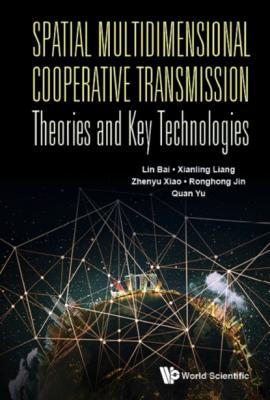Spatial Multidimensional Cooperative Transmission Theories And Key Technologies. Lin Bai
Читать онлайн.| Название | Spatial Multidimensional Cooperative Transmission Theories And Key Technologies |
|---|---|
| Автор произведения | Lin Bai |
| Жанр | Зарубежная компьютерная литература |
| Серия | |
| Издательство | Зарубежная компьютерная литература |
| Год выпуска | 0 |
| isbn | 9789811202476 |
Therefore, SIC detection can be carried out
2. H is a thin matrix
The QR decomposition of H is
where M < N and Q is an unitary matrix. We have
Furthermore,
Since the received signal {xM+1, xM+2, . . . , xN} does not contain any useful information, it can be ignored directly. On this basis, Eqs. (2.161) and (2.164) are identical in form, and thus, successive interference cancellation can be realized. First, sM can be detected based on xM.
If
The above equation shows that since there is no interference term in the detection of sM, the influence of sM can be eliminated during the detection of sM−1. This successive cancellation process can continue until all data signals are detected sequentially. In other words, the mth signal will be detected after the first M – m signals are detected and the interference is eliminated, which can be described as
where
where
Since the successive interference cancellation algorithm introduced above is based on the zero-forcing decision feedback equalizer (ZF-DFE), we call the algorithm a zero-forcing successive interference cancellation (ZF-SIC).12, 13 It should be noted that if the channel state matrix H is a fat matrix with M > N, which means the number of rows of the channel matrix is larger than the number of columns, then the successive interference cancellation algorithms cannot be used in this case due to the lack of an upper triangular array after QR decomposition.
In order to improve system performance, background noise should to be considered when performing the detection. To solve this problem, we need to employ a successive interference cancellation algorithm based on minimum mean square error decision equalizer (MMSE-DFE). And two implementation strategies of MMSE-SIC algorithm are introduced in this section.
Strategy 1: Define the extended channel matrix
where Qex and Rex represent the unitary matrix and the upper triangular matrix, respectively. Replacing y, n, Q, and R in Eq. (2.158) by yex, nex, Qex, and Rex, we get
Based on Eq. (2.170), MMSE-SIC detection can be carried out according to Eqs. (2.158)–(2.168).
Strategy 2: Utilizing the minimum mean square error estimator (MMSE Estimator) directly, the MMSE estimator for signal s1 can be expressed as
where
Assuming that s1 can be detected correctly and its effect can be removed from y, we can obtain
According to y1, s2 can be detected by the MMSE method. And the MMSE-SIC detection of sm can be carried out by repeated interference cancellation and MMSE estimation.
2.4.3Simulation results
As can be seen from Fig. 2.12, the optimal detector ML has obvious advantages compared with the MIMO linear detector (ZF, MMSE). However, the complexity which exponentially increases with the number of transmitting antennas makes it difficult to apply in practical systems. And although linear detectors (ZF, MMSE) have a relatively low complexity, their performance is not satisfactory. The SIC method can improve the performance of the linear detectors (ZF, MMSE) to a certain extent, but their performance is still not on par with ML.
2.5Summary
How to utilize the optimal spatial signal combination and detection method effectively to improve the performance and spectrum efficiency of wireless communication systems is a key issue to be remembered when designing the next generation of wireless communication. The knowledge of spatial multidimensional signal combination and detection is first introduced in this chapter, and then the principle and basic concept of two typical multi-antenna systems, namely the array antenna system and the MIMO antenna system, which can improve the performance and spectrum efficiency of wireless communication system, are also introduced. In Chapter 3, we will elaborate on the principles and techniques of adaptive antennas based on the array antenna system introduced in this chapter.
